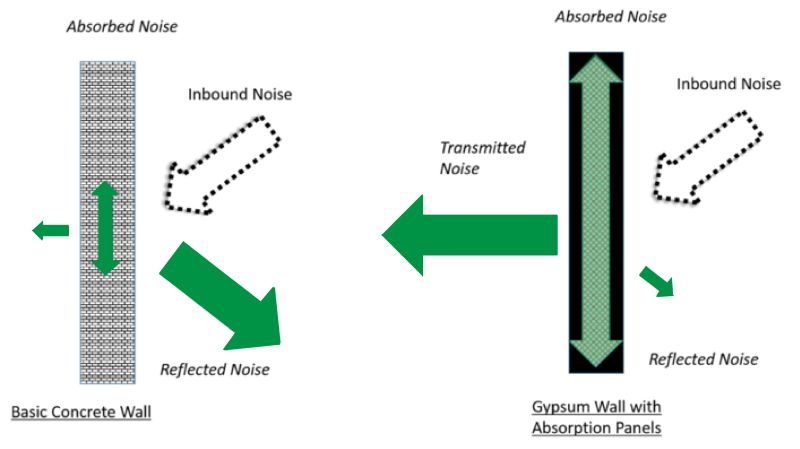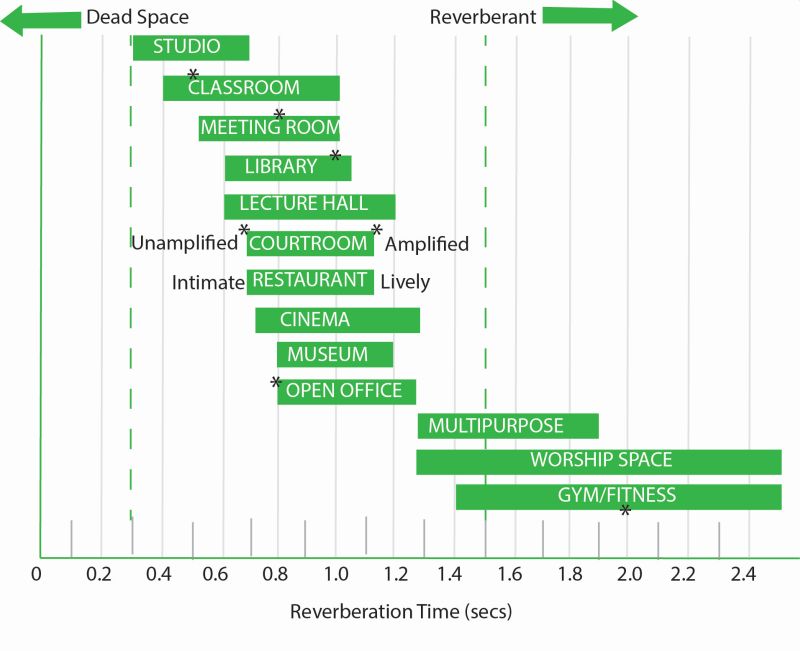The reverberation time for a room is determined by its size and the finishes. However, a target reverberation time is driven by the room’s expected use. Upbeat and active spaces often desire a longer reverb time, while other rooms (where speech intelligibility and comfort are in demand) will require much shorter reverb times. Read below to determine how much reverb time your room needs, and how to achieve it through proper acoustical design.
Common Spaces that Require Acoustic Treatment to Achieve Acceptable Room Reverberation Times
- Courthouses: 1.0 seconds or less in most courtrooms
- Lecture Hall & Classrooms: 0.6 seconds for most classrooms, 1.0 seconds for larger lecture halls
- Restaurants: 0.7-1.1 seconds, from intimate to sports bar
- Multi-Purpose Auditoriums: 1.3 seconds is acceptable. Should never exceed 1.5 seconds reverb time.
- Churches & Worship Centers: fellowship halls should be less than 1.2 seconds. Churches with classical music may desire longer reverb, while contemporary services will desire 1.5 seconds or less.
- Conference Rooms (if telecoms are to be held): less than 0.7 seconds, especially if microphones are used
- Recording Rooms & Studios: 0.3 seconds is ideal. Reverb may be added in, but more difficult to edit out.
- Performance Venues: 1.2 seconds, and also require broadband acoustical absorption
Acoustic Design Steps: Define Use of Room –> Determine Target Reverberation Time -‐> Design Acoustic Treatments if Needed
How Loud Should My Room Be?
A common question we get at Commercial Acoustics is “How Loud Should my space be”? For example, some restaurant managers prefer a “lively” space, while others desire a more “intimate” setting. While there is a fair amount of preference and subjectivity with these considerations, there is also a scientific approach. You can get an upbeat feel, while still maintaining speech comfort for your clients, by selecting an appropriate Target Reverberation Time.
See How Much Absorption You Need with our Acoustic Calculator
Common Acoustical Coefficients for Room Finishes
Certain rooms require stricture reverberation time limits than others. For instance, a closed office or hotel room is not likely to need clear communication between numerous people. Likewise, small gymnasiums that are used for only sports aren’t critical. Even spaces with many people may be neglected acoustically if speaking engagements are not common – such as warehouses and factories.
Spaces where speech intelligibility is important, or even critical, include classrooms, restaurants, lecture halls, and others. Also, venues where crisp acoustics improve the experience often have constrained reverberation, such as museums, theaters, and performance halls.
Lower reverberation is NOT always better. Restaurants, for instance, desired a reverb time from 0.7-1.1 seconds, depending on the desired liveliness of the space. Fine dining or intimate restaurants often desire 0.7 second reverberation, while a lively sports bar or up-‐tempo venue may desire closer to 1.1 seconds. In the latter, a low reverb time may have the undesired effect of making it sound “dead”.
Common NRC (Noise Reduction Coefficient) Ratings
In order to reduce the reverb time in a space, NRC-rated materials should be placed throughout, whether it’s acoustic wall panels, acoustical stretched fabric wall, plush furniture, carpet or other absorptive materials.

Glass and tile have an absorption coefficient (NRC, or Noise Reduction Coefficient) of approximately 0, meaning that they reflect or transmit 100% of the sound energy that impacts them, and absorb none of it. Hardwood and drywall are not much better, absorbing only about 15% of the energy.

In rooms with carpeting and ceiling tiles, acoustic treatment is not a priority since these vary in NRC from 0.4 to 0.6. However, treatment may still be necessary if the volume of the room sufficiently large.




